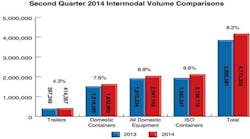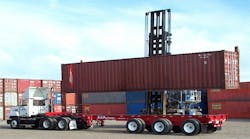Intermodal shipping posted gains across all segments, peaking in the second quarter, according to the Intermodal Association of North America’s (IANA) Intermodal Market Trends & Statistics report. International containers increased 9.6 percent, trailers improved by 4.3 percent, and domestic containers grew 7.6 percent quarter over quarter, all indications that the intermodal industry is recovering from a harsh winter and a contracted economy.
Due in large part to Q2’s strength, the first half of 2014 averaged 5.5 percent in total intermodal volume gains, just below the 5.8 percent growth recorded in the second half of 2013 and in-line with recent trends.
“The second quarter results were indicative of a rebounding economy and higher than predicted import shipments,” said Joni Casey, president and CEO of IANA. “It is also probable the harsh winter that resulted in constricted Q1 capacity contributed to the second quarter’s strong growth, by comparison.”
The seven highest-density trade corridors, accounting for 66.2 percent of total intermodal volume, rose 7.4 percent this quarter, falling below the 8.2 percent industry average. Five of the seven bi-directional lanes recorded growth near or above industry averages. The Trans-Canada corridor, positively impacted by international intermodal shipments from Eastern Canada to Western Canada, led the way in corridor growth with a 10.5 percent quarter-over-quarter increase.
Eight of the nine IANA regions experienced growth in the second quarter, with six areas reporting increases larger than 10 percent. Of these six, all were heavily impacted by strong showings in international intermodal shipments. The Midwest and Southwest, the two largest IANA regions accounting for almost 50 percent of total loadings, climbed 6.3 percent and 7.8 percent, respectively.
Intermodal Marketing Companies (IMCs) posted Q2 growth rates that were more modest than the overall intermodal volume numbers, growing 2.4 percent from last year. Like much of the broader market, IMCs in part benefited from the robust showing from imports based on transloading opportunities. Average revenue for both intermodal and highway IMC market segments continued its strong growth, with increases of 6.0 percent and 16.3 percent respectively. A month-by-month IMC growth comparison indicates that April led the way with solid 4.2 percent gains, then slowed to 0.9 percent in May and 2 percent in June. In quarter-over-quarter comparisons, intermodal business accelerated 6.7 percent.




